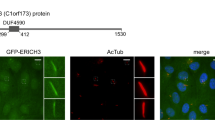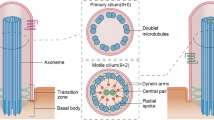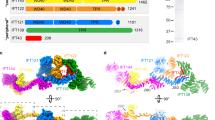Abstract
The bidirectional movement of intraflagellar transport (IFT) particles, which are composed of motors, IFT-A and IFT-B subcomplexes, and cargoes, is required for the biogenesis and signalling of cilia1,2. A successful IFT cycle depends on the proper assembly of the massive IFT particle at the ciliary base and its turnaround from anterograde to retrograde transport at the ciliary tip. However, how IFT assembly and turnaround are regulated in vivo remains elusive. From a whole-genome mutagenesis screen in Caenorhabditis elegans, we identified two hypomorphic mutations in dyf-2 and bbs-1 as the only mutants showing normal anterograde IFT transport but defective IFT turnaround at the ciliary tip. Further analyses revealed that the BBSome (refs 3, 4), a group of conserved proteins affected in human Bardet–Biedl syndrome5 (BBS), assembles IFT complexes at the ciliary base, then binds to the anterograde IFT particle in a DYF-2- (an orthologue of human WDR19) and BBS-1-dependent manner, and lastly reaches the ciliary tip to regulate proper IFT recycling. Our results identify the BBSome as the key player regulating IFT assembly and turnaround in cilia.
This is a preview of subscription content, access via your institution
Access options
Subscribe to this journal
Receive 12 print issues and online access
$209.00 per year
only $17.42 per issue
Buy this article
- Purchase on Springer Link
- Instant access to full article PDF
Prices may be subject to local taxes which are calculated during checkout





Similar content being viewed by others
References
Pedersen, L. B. & Rosenbaum, J. L. Intraflagellar transport (IFT) role in ciliary assembly, resorption and signalling. Curr. Top. Dev. Biol. 85, 23–61 (2008).
Scholey, J. M. & Anderson, K. V. Intraflagellar transport and cilium-based signaling. Cell 125, 439–442 (2006).
Nachury, M. V. et al. A core complex of BBS proteins cooperates with theGTPase Rab8 to promote ciliary membrane biogenesis. Cell 129, 1201–1213 (2007).
Loktev, A. V. et al. A BBSome subunit links ciliogenesis, microtubule stability, and acetylation. Dev. Cell 15, 854–865 (2008).
Zaghloul, N. A. & Katsanis, N. Mechanistic insights into Bardet–Biedl syndrome, a model ciliopathy. J. Clin. Invest. 119, 428–437 (2009).
Rosenbaum, J. L. & Witman, G. B. Intraflagellar transport. Nat. Rev. Mol. Cell Biol. 3, 813–825 (2002).
Pedersen, L. B., Geimer, S. & Rosenbaum, J. L. Dissecting the molecular mechanisms of intraflagellar transport in Chlamydomonas. Curr. Biol. 16, 450–459 (2006).
Hedgecock, E. M., Culotti, J. G., Thomson, J. N. & Perkins, L. A. Axonal guidance mutants of Caenorhabditis elegans identified by filling sensory neurons with fluorescein dyes. Dev. Biol. 111, 158–170 (1985).
Efimenko, E. et al. Caenorhabditis elegans DYF-2, an orthologue of human WDR19, is a component of the intraflagellar transport machinery in sensory cilia. Mol. Biol. Cell 17, 4801–4811 (2006).
Ou, G., Blacque, O. E., Snow, J. J., Leroux, M. R. & Scholey, J. M. Functional coordination of intraflagellar transport motors. Nature 436, 583–587 (2005).
Snow, J. J. et al. Two anterograde intraflagellar transport motors cooperate to build sensory cilia on C. elegans neurons. Nat. Cell Biol. 6, 1109–1113 (2004).
Hu, C. D., Chinenov, Y. & Kerppola, T. K. Visualization of interactions among bZIP and Rel family proteins in living cells using bimolecular fluorescence complementation. Mol. Cell 9, 789–798 (2002).
Cole, D. G. et al. Chlamydomonas kinesin-II-dependent intraflagellar transport (IFT): IFT particles contain proteins required for ciliary assembly in Caenorhabditis elegans sensory neurons. J. Cell Biol. 141, 993–1008 (1998).
Iomini, C., Li, L., Esparza, J. M. & Dutcher, S. K. Retrograde intraflagellar transport mutants identify complex A proteins with multiple genetic interactions in Chlamydomonas reinhardtii. Genetics 183, 885–896 (2009).
Piperno, G. et al. Distinct mutants of retrograde intraflagellar transport (IFT) share similar morphological and molecular defects. J. Cell Biol. 143, 1591–1601 (1998).
Iomini, C., Babaev-Khaimov, V., Sassaroli, M. & Piperno, G. Protein particles in Chlamydomonas flagella undergo a transport cycle consisting of four phases. J. Cell Biol. 153, 13–24 (2001).
Liem, K. F. Jr et al. The IFT-A complex regulates Shh signaling through cilia structure and membrane protein trafficking. J. Cell Biol. 197, 789–800 (2012).
Pazour, G. J., Wilkerson, C. G. & Witman, G. B. A dynein light chain is essential for the retrograde particle movement of intraflagellar transport (IFT). J. Cell Biol. 141, 979–992 (1998).
Signor, D. et al. Role of a class DHC1b dynein in retrograde transport of IFT motors and IFT raft particles along cilia, but not dendrites, in chemosensory neurons of living Caenorhabditis elegans. J. Cell Biol. 147, 519–530 (1999).
Schafer, J. C., Haycraft, C. J., Thomas, J. H., Yoder, B. K. & Swoboda, P. XBX-1 encodes a dynein light intermediate chain required for retrograde intraflagellar transport and cilia assembly in Caenorhabditis elegans. Mol. Biol. Cell 14, 2057–2070 (2003).
Fliegauf, M., Benzing, T. & Omran, H. When cilia go bad: cilia defects and ciliopathies. Nat. Rev. Mol. Cell Biol. 8, 880–893 (2007).
Li, J. B. et al. Comparative genomics identifies a flagellar and basal body proteome that includes the BBS5 human disease gene. Cell 117, 541–552 (2004).
Lechtreck, K. F. et al. The Chlamydomonas reinhardtii BBSome is an IFT cargo required for export of specific signaling proteins from flagella. J. Cell Biol. 187, 1117–1132 (2009).
Tayeh, M. K. et al. Genetic interaction between Bardet–Biedl syndrome genes and implications for limb patterning. Human Mol. Genet. 17, 1956–1967 (2008).
Yen, H. J. et al. Bardet–Biedl syndrome genes are important in retrograde intracellular trafficking and Kupffer’s vesicle cilia function. Human Mol. Genet. 15, 667–677 (2006).
Fath, M. A. et al. Mkks-null mice have a phenotype resembling Bardet–Biedl syndrome. Human Mol. Genet. 14, 1109–1118 (2005).
Mykytyn, K. et al. Bardet–Biedl syndrome type 4 (BBS4)-null mice implicate Bbs4 in flagella formation but not global cilia assembly. Proc. Natl Acad. Sci. USA 101, 8664–8669 (2004).
Nishimura, D. Y. et al. Bbs2-null mice have neurosensory deficits, a defect in social dominance, and retinopathy associated with mislocalization of rhodopsin. Proc. Natl Acad. Sci. USA 101, 16588–16593 (2004).
Shah, A. S. et al. Loss of Bardet–Biedl syndrome proteins alters the morphology and function of motile cilia in airway epithelia. Proc. Natl Acad. Sci. USA 105, 3380–3385 (2008).
Davis, R. E. et al. A knockin mouse model of the Bardet–Biedl syndrome 1 M390R mutation has cilia defects, ventriculomegaly, retinopathy, and obesity. Proc. Natl Acad. Sci. USA 104, 19422–19427 (2007).
Ou, G. et al. Sensory ciliogenesis in Caenorhabditis elegans: assignment of IFT components into distinct modules based on transport and phenotypic profiles. Mol. Biol. Cell 18, 1554–1569 (2007).
Pan, X. et al. Mechanism of transport of IFT particles in C. elegans cilia by the concerted action of kinesin-II and OSM-3 motors. J. Cell Biol. 174, 1035–1045 (2006).
Blacque, O. E. et al. Loss of C. elegans BBS-7 and BBS-8 protein function results in cilia defects and compromised intraflagellar transport. Genes Dev. 18, 1630–1642 (2004).
Tran, P. V. et al. THM1 negatively modulates mouse sonic hedgehog signal transduction and affects retrograde intraflagellar transport in cilia. Nat. Genet. 40, 403–410 (2008).
May, S.R. et al. Loss of the retrograde motor for IFT disrupts localization of Smo to cilia and prevents the expression of both activator and repressor functions of Gli. Dev. Biol. 287, 378–389 (2005).
Huangfu, D. & Anderson, K. V. Cilia and Hedgehog responsiveness in the mouse. Proc. Natl Acad. Sci. USA 102, 11325–11330 (2005).
Berbari, N. F., Lewis, J. S., Bishop, G. A., Askwith, C. C. & Mykytyn, K. Bardet–Biedl syndrome proteins are required for the localization of G protein-coupled receptors to primary cilia. Proc. Natl Acad. Sci. USA 105, 4242–4246 (2008).
Jin, H. et al. The conserved Bardet–Biedl syndrome proteins assemble a coat that traffics membrane proteins to cilia. Cell 141, 1208–1219 (2010).
Gerdes, J. M. et al. Disruption of the basal body compromises proteasomal function and perturbs intracellular Wnt response. Nat. Genet. 39, 1350–1360 (2007).
Kim, J. C. et al. The Bardet–Biedl protein BBS4 targets cargo to the pericentriolar region and is required for microtubule anchoring and cell cycle progression. Nat. Genet. 36, 462–470 (2004).
Brenner, S. The genetics of Caenorhabditis elegans. Genetics 77, 71–94 (1974).
Davis, M.W. et al. Rapid single nucleotide polymorphism mapping in C. elegans. BMC Genom. 6, 118 (2005).
Li, Y., Wei, Q., Zhang, Y., Ling, K. & Hu, J. The small GTPases ARL-13 and ARL-3 coordinate intraflagellar transport and ciliogenesis. J. Cell Biol. 189, 1039–1051 (2010).
Shyu, Y. J. et al. Visualization of protein interactions in living Caenorhabditis elegans using bimolecular fluorescence complementation analysis. Nat. Protocol. 3, 588–596 (2008).
Acknowledgements
We thank the Caenorhabditis Genetics Center, the Japanese Bioresource Project, J. Scholey (University of California, Davis, USA), M. Leroux (Simon Fraser University, Canada) and M. Barr (Rutgers University, USA) for strains; and A. Fire (Stanford University, USA) for GFP vectors. J.H. and co-workers were supported by the National Institutes of Health research grant 1R01DK090038 and P30 center grant P30DK90728, a Pilot and Feasibility Award from the Mayo Clinic Center for Cell Signaling in Gastroenterology (P30DK084567) and the PKD Foundation Young Investigator Award 04YI09a. J.H. was also supported by a FULK Career Development Award, a Zell PKD Research Award and the Upjohn PKD Research Fund. K.L. was supported by the National Cancer Institute (NCI; 1R01CA149039-01A1), Susan G. Komen for the Cure (KG100902) and the National Institute of Diabetes and Digestive and Kidney Diseases (P30DK90728).
Author information
Authors and Affiliations
Contributions
J.H. conceived the initial concept for the screen. J.H., Q.W., Y.L. and Y.Z. performed the screening and mapped the mutants. Q.W. and Y.Z. generated transgenic animals and performed image analysis with the support of Q.Z. Y.Z. carried out all microinjections. Q.W. and K.L. carried out biochemical assays with the support of Y.Z. K.L. and J.H. wrote the manuscript with contributions from Q.W., Y.Z., Y.L. and Q.Z.
Corresponding author
Ethics declarations
Competing interests
The authors declare no competing financial interests.
Supplementary information
Supplementary Information
Supplementary Information (PDF 652 kb)
Supplementary Table 1
Supplementary Information (XLS 40 kb)
Supplementary Table 2
Supplementary Information (XLS 42 kb)
Supplementary Table 3
Supplementary Information (XLS 28 kb)
Supplementary Movie 1
Supplementary Information (AVI 1959 kb)
Supplementary Movie 2
Supplementary Information (AVI 6312 kb)
Supplementary Movie 3
Supplementary Information (AVI 5017 kb)
Supplementary Movie 4
Supplementary Information (AVI 2335 kb)
Supplementary Movie 5
Supplementary Information (AVI 3905 kb)
Supplementary Movie 6
Supplementary Information (AVI 4402 kb)
Supplementary Movie 7
Supplementary Information (AVI 4794 kb)
Supplementary Movie 8
Supplementary Information (AVI 2429 kb)
Supplementary Movie 9
Supplementary Information (AVI 3008 kb)
Supplementary Movie 10
Supplementary Information (AVI 1786 kb)
Supplementary Movie 11
Supplementary Information (AVI 3129 kb)
Supplementary Movie 12
Supplementary Information (AVI 4158 kb)
Supplementary Movie 13
Supplementary Information (AVI 2445 kb)
Supplementary Movie 14
Supplementary Information (AVI 3915 kb)
Supplementary Movie 15
Supplementary Information (AVI 1900 kb)
Supplementary Movie 16
Supplementary Information (AVI 1712 kb)
Supplementary Movie 17
Supplementary Information (AVI 4903 kb)
Supplementary Movie 18
Supplementary Information (AVI 4052 kb)
Supplementary Movie 19
Supplementary Information (AVI 10787 kb)
Supplementary Movie 20
Supplementary Information (AVI 2545 kb)
Supplementary Movie 21
Supplementary Information (AVI 4215 kb)
Supplementary Movie 22
Supplementary Information (AVI 1708 kb)
Supplementary Movie 23
Supplementary Information (AVI 1739 kb)
Supplementary Movie 24
Supplementary Information (AVI 3810 kb)
Supplementary Movie 25
Supplementary Information (AVI 1162 kb)
Supplementary Movie 26
Supplementary Information (AVI 11128 kb)
Supplementary Movie 27
Supplementary Information (AVI 3075 kb)
Supplementary Movie 28
Supplementary Information (AVI 4667 kb)
Supplementary Movie 29
Supplementary Information (AVI 1706 kb)
Supplementary Movie 30
Supplementary Information (AVI 5069 kb)
Supplementary Movie 31
Supplementary Information (AVI 5048 kb)
Supplementary Movie 32
Supplementary Information (AVI 1464 kb)
Supplementary Movie 33
Supplementary Information (AVI 1406 kb)
Supplementary Movie 34
Supplementary Information (AVI 5342 kb)
Supplementary Movie 35
Supplementary Information (AVI 2400 kb)
Rights and permissions
About this article
Cite this article
Wei, Q., Zhang, Y., Li, Y. et al. The BBSome controls IFT assembly and turnaround in cilia. Nat Cell Biol 14, 950–957 (2012). https://doi.org/10.1038/ncb2560
Received:
Accepted:
Published:
Issue Date:
DOI: https://doi.org/10.1038/ncb2560
This article is cited by
-
Appearing and disappearing acts of cilia
Journal of Biosciences (2023)
-
Vangl2 participates in the primary ciliary assembly under low fluid shear stress in hUVECs
Cell and Tissue Research (2022)
-
TALPID3 and ANKRD26 selectively orchestrate FBF1 localization and cilia gating
Nature Communications (2020)
-
Motile ciliopathies
Nature Reviews Disease Primers (2020)
-
Evidence for secondary-variant genetic burden and non-random distribution across biological modules in a recessive ciliopathy
Nature Genetics (2020)



